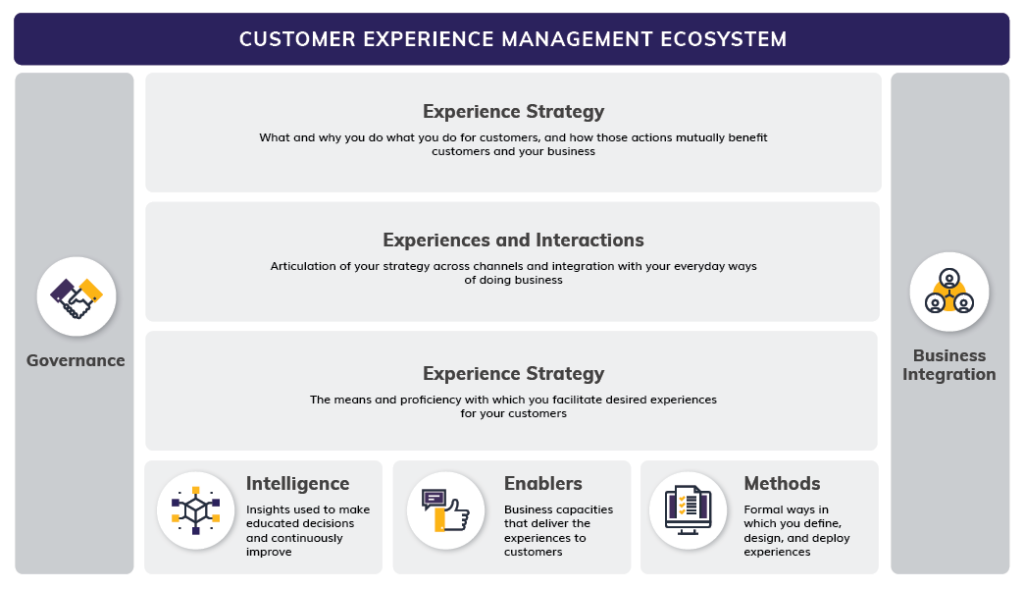The time and money you invest in customer understanding can be significant, but the costs of not investing in them and an overarching customer experience management (CXM) strategy can be much greater.
Previous blog posts have explored three methods for gathering qualitative information about your customers: in-depth customer interviews, journey mapping and observational interviews. Still, leaders may wonder, “These are expensive – haven’t we done enough?”
While each tool does provide valuable insights in its own way, they can only achieve their full potential as part of a customer experience management (CXM) strategy. Investing in such a strategy is essential to becoming a fully realized customer-centric organization.
Why? Because CXM evolves the customer experience design (CX)/customer centricity movement. As organizations have realized that true CX is an ideology that must permeate the entire organization, they have also realized their need for a strategy vehicle that will allow them to properly design for, engage with and manage customer experiences.
CXM fills this strategic gap. It is the ideology that allows organizations to react to and design for their desired audiences based on the insights and information they already have or gather through interviews, journey mapping or other methods. A mature CXM capability allows them to constantly evolve how their brands interact with their constituents.
Preparing for the Journey to Customer Experience Management
Where most brands fail is assimilating CXM (the creative process of experience development) and customer experience design (CXD, determining what they need to create to deliver that experience). Not a stand-alone entity, CXD helps fully enable CXM across an organization’s functional areas. Here is how we think of the way CXM and CXD go together to ensure success:
Organizations must realize a few things before they can set out on their journey to CXM:
1. You must earn the right to do more with customers.
When evolving into CXM, brands need to start small. Fix the things users expect from you. These are things your brand stands for and are known for. However, they don’t mean much if you don’t fulfill your promises to your customers. Fixing things that matter most – the expectations of your brand promises – will inherently begin to build more trust more quickly. Additionally, you will learn what you are and are not ready for based on how mature your organization is when compared to standard CXM models similar to ours above.
2. All things are not created equal, and that’s OK.
As you become more mature and can prove to yourself the right structures are in place for CXM – the right in-house skills, partner capabilities, data needed for decision making and so on – you will quickly realize you have places to focus on that will drive more value than others. The key to success isn’t necessarily to only maximize those opportunities but also how can you build on your successes to implement and adapt the other services and experiences. Doing so will automatically decrease the cost to serve customers, therefore creating more value, just in a different way.
3. CXM maturity will change the entire organization over time, more than leadership teams realize, and that’s OK.
In fact, it’s expected. As brands mature their models and further integrate into business operations, things will change, but they will change for the better. New perspectives on decision making, communication, planning and so on will benefit every facet of your operations. In turn, your organization will experience excitement as new core competencies emerge that will better manifest the idea of CXM. Affected assets include:
- People and Organizations
- Operations and Process
- Business Architecture and Domain strategies
- Ways of Working
- Skills
- Human Resources
- Revenue Models and Finance.
How CXM Applies to Technology Organizations
Technology organizations are evolving the administration of CXM frameworks, signifying a large shift from thinking to doing. Organizations that are working this way, not just thinking or talking about it, are well aligned to the ideas of starting small, learning and earning the right to do more and maturing over time.
You are building a holistic way to manage your customer’s experiences, to reach the right audiences with relevant experiences at the right time, to empower them to make decisions and to create enriched relationships. You are building the foundational ecosystem for CXM or the experience management platform (EMP) — a fully integrated set of enablers that will better facilitate and manifest the experiences audiences deserve and, more importantly, find value in using.
By building from the ground up, you inherently will acquire a few new attributes for CXM specifically integrated with your EMP:
- Intelligence and information will come in new forms and new indicators that can answer new questions. This further exemplifies the purpose of your framework and what you are trying to accomplish: getting smarter about customer needs and your focus on them to create more value.
- Methods and ways of working will evolve to imbed the idea of continuous integration/continuous delivery (CI/CD) but from an experience perspective, not just a technology release standpoint. That will also lead to improved and fresher data sets you can transform into insights.
- Modern technology enablers, when integrated, will dramatically simplify technology operations and the limited total cost of ownership of your systems. Building on your architecture, create the most scalable way to extend your strategy into a set of tools and applications technologists want to build, and that will better enable upstream users.
- Efficient and intelligent new capabilities will emerge that spearhead optimizations and enhancements of the experiences that drive the CI/CD perspective, therefore manifesting into fresh data and insights.
Conclusion: CXM Is Worth the Investment
All CX work requires significant investments of time and money. However, investing further in CXM will make the most of your investments in tools such as interviews and journey mapping and the CX work that follows to turn that qualitative research into new experiences. Without investing in CXM, you risk leaving a lot of value on the table, which can have long-term effects on your company, your people and your customers.


